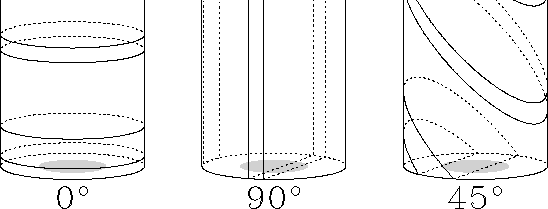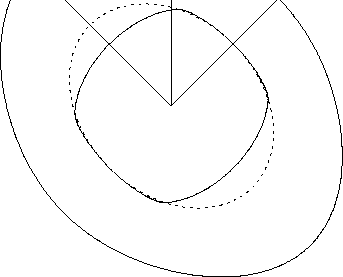![[*]](http://sepwww.stanford.edu/latex2html/cross_ref_motif.gif) give us
accurate vertical phase velocities, accurate vertical group velocities, or
something in between?
give us
accurate vertical phase velocities, accurate vertical group velocities, or
something in between?
![[*]](http://sepwww.stanford.edu/latex2html/cross_ref_motif.gif) ).
Elastic constants are then determined from the set of recorded travel
times.
).
Elastic constants are then determined from the set of recorded travel
times.
Before we can determine accurate elastic constants from the recorded
traveltimes, however, we need to know what velocities the recorded
traveltimes depend on.
Theoretically we know that if we could somehow
do the experiment using ideal point sources and receivers,
we would really be measuring group velocities along the direction from point
source to point receiver.
Similarly, if we could somehow do the experiment using infinite parallel planar
sources and receivers, we would really be measuring phase velocities along the
direction normal to the source and receiver planes.
While neither of these idealized experiments is possible in practice,
we usually expect to be close enough to one extreme or the other
to know what we are measuring, and for the error to be reasonably small.
But is this common assumption correct?
In particular,
do the traveltimes measured in a laboratory experiment like the one
in Figure ![[*]](http://sepwww.stanford.edu/latex2html/cross_ref_motif.gif) give us
accurate vertical phase velocities, accurate vertical group velocities, or
something in between?
give us
accurate vertical phase velocities, accurate vertical group velocities, or
something in between?
 |
To find out, we examine the results of a computer finite-difference model patterned after a laboratory experiment done by Vernik and Nur (in press). Their experiment was chosen because it must be close to the ``worst-case'' likely to be encountered for any geological sample. The P-wave transducers were 12 millimeters wide but 40 millimeters apart, so the distance the waves traveled was fully three times farther than the size of the source and receiver. Furthermore, the anisotropy of their Bakken Shale sample was quite severe, about the worst we might expect to encounter in a geological sample. Despite these vicissitudes, Vernik and Nur proceeded on the assumption (based on geometrical arguments) that their measured traveltimes still represented phase velocities.
Our numerical modeling shows that Vernik and Nur were correct to do so.
The only phase-velocity error due to the severe anisotropy that might
have affected their results is a ![]() delay in
the
delay in
the ![]() P-wave measurement. Given that they found typical random
errors on their measurements were about
P-wave measurement. Given that they found typical random
errors on their measurements were about ![]() to
to ![]() ,an additional
,an additional ![]() of error is almost insignificant.
The numerical model furthermore shows that
for the experiment to have measured P group velocities to a similar
level of accuracy,
the transducers should have been at most 2mm wide!
We conclude that laboratory experiments of this kind should
almost always measure accurate phase velocities; at the very worst
they may measure something hard to interpret
in the never-never land between group and phase.
of error is almost insignificant.
The numerical model furthermore shows that
for the experiment to have measured P group velocities to a similar
level of accuracy,
the transducers should have been at most 2mm wide!
We conclude that laboratory experiments of this kind should
almost always measure accurate phase velocities; at the very worst
they may measure something hard to interpret
in the never-never land between group and phase.
|
Waves
Figure 2 Impulse-response curves showing the shapes of wavefronts propagating in the medium used in our numerical models: qP (outer curve), qSV (inner solid curve), and SH (dotted). The |  |